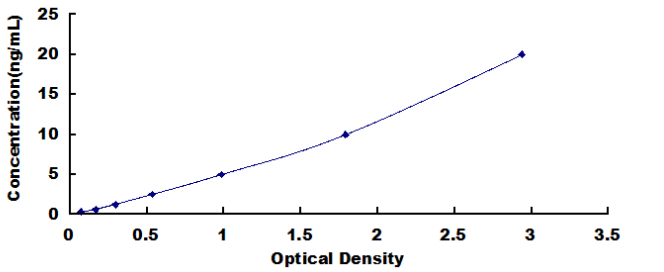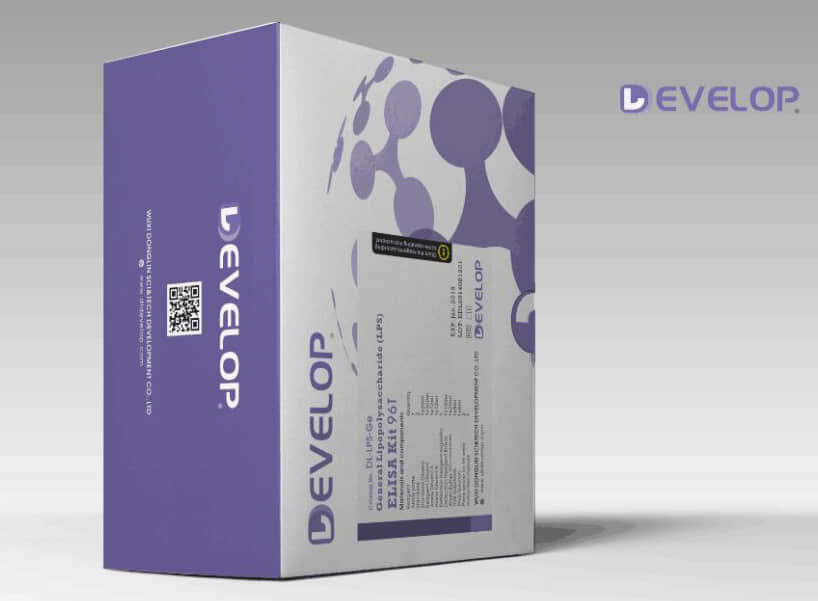Human Brevican (BCAN) ELISA Kit


two product lines: Traditional ELISA Kit and Ready-to-Use ELISA Kit.


Other names:BEHAB; CSPG7; Chondroitin Sulfate Proteoglycan 7; Brevican Proteoglycan; Brevican core protein; Brain-enriched hyaluronan-binding protein
Function: May play a role in the terminally differentiating and the adult nervous system during postnatal development. Could stabilize interactions between hyaluronan (HA) and brain proteoglycans.
Sequence:
10 20 30 40 50 MAQLFLPLLA ALVLAQAPAA LADVLEGDSS EDRAFRVRIA GDAPLQGVLG 60 70 80 90 100 GALTIPCHVH YLRPPPSRRA VLGSPRVKWT FLSRGREAEV LVARGVRVKV 110 120 130 140 150 NEAYRFRVAL PAYPASLTDV SLALSELRPN DSGIYRCEVQ HGIDDSSDAV 160 170 180 190 200 EVKVKGVVFL YREGSARYAF SFSGAQEACA RIGAHIATPE QLYAAYLGGY 210 220 230 240 250 EQCDAGWLSD QTVRYPIQTP REACYGDMDG FPGVRNYGVV DPDDLYDVYC 260 270 280 290 300 YAEDLNGELF LGDPPEKLTL EEARAYCQER GAEIATTGQL YAAWDGGLDH 310 320 330 340 350 CSPGWLADGS VRYPIVTPSQ RCGGGLPGVK TLFLFPNQTG FPNKHSRFNV 360 370 380 390 400 YCFRDSAQPS AIPEASNPAS NPASDGLEAI VTVTETLEEL QLPQEATESE 410 420 430 440 450 SRGAIYSIPI MEDGGGGSST PEDPAEAPRT LLEFETQSMV PPTGFSEEEG 460 470 480 490 500 KALEEEEKYE DEEEKEEEEE EEEVEDEALW AWPSELSSPG PEASLPTEPA 510 520 530 540 550 AQEESLSQAP ARAVLQPGAS PLPDGESEAS RPPRVHGPPT ETLPTPRERN 560 570 580 590 600 LASPSPSTLV EAREVGEATG GPELSGVPRG ESEETGSSEG APSLLPATRA 610 620 630 640 650 PEGTRELEAP SEDNSGRTAP AGTSVQAQPV LPTDSASRGG VAVVPASGDC 660 670 680 690 700 VPSPCHNGGT CLEEEEGVRC LCLPGYGGDL CDVGLRFCNP GWDAFQGACY 710 720 730 740 750 KHFSTRRSWE EAETQCRMYG AHLASISTPE EQDFINNRYR EYQWIGLNDR 760 770 780 790 800 TIEGDFLWSD GVPLLYENWN PGQPDSYFLS GENCVVMVWH DQGQWSDVPC 810 820 830 840 850 NYHLSYTCKM GLVSCGPPPE LPLAQVFGRP RLRYEVDTVL RYRCREGLAQ 860 870 880 890 900 RNLPLIRCQE NGRWEAPQIS CVPRRPARAL HPEEDPEGRQ GRLLGRWKAL 910 LIPPSSPMPG P
INTENDED USE
The kit is a sandwich enzyme immunoassay for the in vitro quantitative measurement of BCAN in human tissue homogenates, cell lysates or other biological fluids.
DETECTION RANGE
0.312-20ng/mL. The standard curve concentrations used for the ELISA’s were 20ng/mL, 10ng/mL, 5ng/mL, 2.5ng/mL, 1.25ng/mL, 0.625ng/mL, 0.312ng/mL.
SENSITIVITY
The minimum detectable dose of BCAN is typically less than 0.128ng/mL.
The sensitivity of this assay, or Lower Limit of Detection (LLD) was defined as the lowest protein concentration that could be differentiated from zero. It was determined by adding two standard deviations to the mean optical density value of twenty zero standard replicates and calculating the corresponding concentration.
SPECIFICITY
This assay has high sensitivity and excellent specificity for detection of BCAN.
No significant cross-reactivity or interference between BCAN and analogues was observed.
You can reference link of the kit as following
https://dldevelop.com/Research-reagent/dl-bcan-hu.html
https://www.dldevelop.com/uploadfile/data/DL-BCAN-Hu.pdf
Introduction
| Item | Standard | Test | |
| Description |
The kit is a sandwich enzyme immunoassay for the in vitro quantitative measurement of BCAN in human serum, plasma,tissue homogenates, cell lysates and other biological fluids. |
Conform | |
| Identification | Colorimetric | Positive | |
| Composition | Traditional ELISA Kit | Ready-to-Use ELISA KIT | Conform |
| Pre-coated, ready to use 96-well strip plate 1 | Pre-coated, ready to use 96-well strip plate 1 | ||
| Plate sealer for 96 wells 2 | Plate sealer for 96 wells 2 | ||
| Standard 2 | Standard 2 | ||
| Diluents buffer 1×45mL | Standard Diluent 1×20mL | ||
| Detection Reagent A 1×120μL | Detection Solution A 1×12mL | ||
| Detection Reagent B 1×120μL | Detection Solution B 1×12mL | ||
| TMB Substrate 1×9mL | TMB Substrate 1×9mL | ||
| Stop Solution 1×6mL | Stop Solution 1×6mL | ||
| Wash Buffer (30 × concentrate) 1×20mL | Wash Buffer (30 × concentrate) 1×20mL | ||
| Instruction manual 1 | Instruction manual 1 | ||
Test principle
The microtiter plate provided in this kit has been pre-coated with an antibody specific to the index. Standards or samples are then added to the appropriate microtiter plate wells with a biotin-conjugated antibody preparation specific to the index. Next, Avidin conjugated to Horseradish Peroxidase (HRP) is added to each microplate well and incubated. After TMB substrate solution is added, only those wells that contain the index, biotin-conjugated antibody and enzyme-conjugated Avidin will exhibit a change in color. The enzyme-substrate reaction is terminated by the addition of sulphuric acid solution and the color change is measured spectrophotometrically at a wavelength of 450nm ± 10nm. The concentration of the index in the samples is then determined by comparing the O.D. of the samples to the standard curve.
Recovery
Matrices listed below were spiked with certain level of recombinant BCAN and the recovery rates were calculated by comparing the measured value to the expected amount of the index in samples.
| Matrix | Recovery range (%) | Average(%) |
| serum(n=5) | 81-93 | 86 |
| EDTA plasma(n=5) | 80-97 | 88 |
| heparin plasma(n=5) | 90-101 | 95 |
Linearity
The linearity of the kit was assayed by testing samples spiked with appropriate concentration of the index and their serial dilutions. The results were demonstrated by the percentage of calculated concentration to the expected.
| Sample | 1:2 | 1:4 | 1:8 | 1:16 |
| serum(n=5) | 82-96% | 83-98% | 81-99% | 93-101% |
| EDTA plasma(n=5) | 88-101% | 86-95% | 90-102% | 80-93% |
| heparin plasma(n=5) | 80-91% | 82-90% | 95-104% | 79-95% |
Precision
Intra-assay Precision (Precision within an assay): 3 samples with low, middle and high level the index were tested 20 times on one plate, respectively.
Inter-assay Precision (Precision between assays): 3 samples with low, middle and high level the index were tested on 3 different plates, 8 replicates in each plate.
CV(%) = SD/meanX100
Intra-Assay: CV<10%
Inter-Assay: CV<12%
Stability
The stability of ELISA kit is determined by the loss rate of activity. The loss rate of this kit is less than 5% within the expiration date under appropriate storage conditions.
Note:
To minimize unnecessary influences on the performance, operation procedures and lab conditions, especially room temperature, air humidity and incubator temperatures should be strictly regulated. It is also strongly suggested that the whole assay is performed by the same experimenter from the beginning to the end.
Assay procedure summary
1. Prepare all reagents, samples and standards;
2. Add 100µL standard or sample to each well. Incubate 2 hours at 37℃;
3. Aspirate and add 100µL prepared Detection Reagent A. Incubate 1 hour at 37℃;
4. Aspirate and wash 3 times;
5. Add 100µL prepared Detection Reagent B. Incubate 1 hour at 37℃;
6. Aspirate and wash 5 times;
7. Add 90µL Substrate Solution. Incubate 15-25 minutes at 37℃;
8. Add 50µL Stop Solution. Read at 450nm immediately.
Order or get a Quote
We will reply you within 24 hours!














